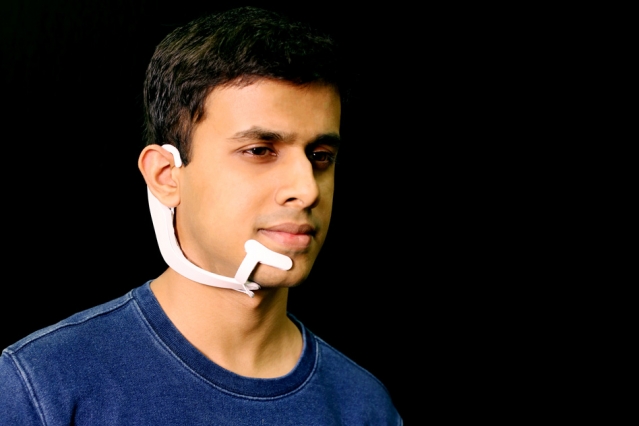Mind-Reading Wearable Translates Silent Words Into Actions
MIT researchers have developed AlterEgo, a headset that can analyze brain activity and bone vibrations to identify your words and obey your commands.
It sounds like it might be straight out of a science fiction movie, but researchers at MIT say they've discovered a way to read your silent speech and translate it into actions.

The technology, called AlterEgo, is an oddly shaped white headset that sits around your ear and curves across your jaw. It's outfitted with electrodes that analyze brain activity and vibrations in your bones when you internally verbalize a message. It takes that data and imports it into a computer that uses neural networks to identify what you were trying to say.
If successful, the system will properly translate your thoughts and convert them into real-world commands.
“The motivation for this was to build an IA device — an intelligence-augmentation device,” MIT Media Lab graduate student Arnav Kapur, who led the team that developed the technology, told MIT News in an interview. "Our idea was: Could we have a computing platform that’s more internal, that melds human and machine in some ways and that feels like an internal extension of our own cognition?”
The headset is designed to explore the world of subvocalization, or internal verbalization. The researchers wanted to see if they could find a way to understand the words and inner talks you have with yourself and extract them for real-world use. And in order to do that, they needed to fully evaluate what happens when we think thoughts that we don't actually verbalize.
In that research, the scientists found that we have seven "electrode locations" that provide hints at what we're thinking. And by creating the headset to wrap around the neck, ear, and jaw, the researchers were able to target all seven and gather information. However, they also discovered they could reduce the size of the headset and tap into only four of those locations and get the same results.
As time goes on, they hope to further reduce the number of locations they need to cover to make the headset smaller and less intrusive.
Sign up to get the BEST of Tom's Guide direct to your inbox.
Get instant access to breaking news, the hottest reviews, great deals and helpful tips.
The researchers told MIT News that they used the technology in a variety of ways, including answering math equations and controlling Roku players. In 92 percent of cases, even though not a single word was uttered out loud, the technology was able to determine their thoughts and accurately respond.
Looking ahead, the researchers believe their technology has a variety of real-world applications in loud environments where traditional headsets might not be able to easily hear commands or a person speaking and respond accordingly. They also believe special operations forces could use it to communicate with each other during a silent mission.
Still, there's no telling when, or even if, the technology might eventually find its way to companies or consumers.
Don Reisinger is CEO and founder of D2 Tech Agency. A communications strategist, consultant, and copywriter, Don has also written for many leading technology and business publications including CNET, Fortune Magazine, The New York Times, Forbes, Computerworld, Digital Trends, TechCrunch and Slashgear. He has also written for Tom's Guide for many years, contributing hundreds of articles on everything from phones to games to streaming and smart home.
